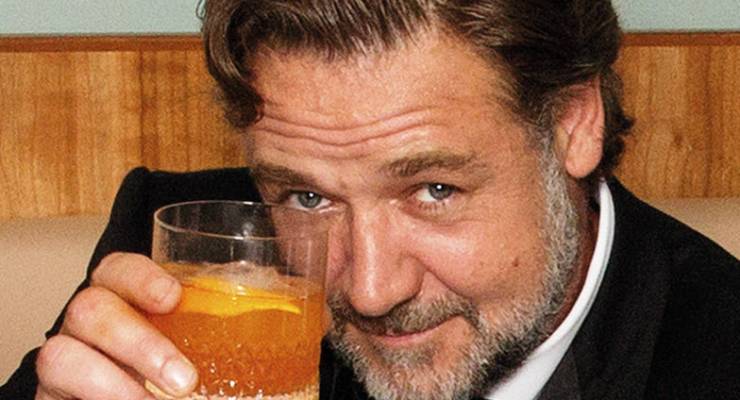
It’s a tricky thing, the celebrity chattels auction. You need the general public to believe that these objects, often quite mundane, have been sprinkled with stardust. The vendor has to spruik the sale without sounding avaricious (it helps if they’re dead). And into this suspension of disbelief steps the upper-class auction house, eager to Posh Up the proceedings and rake in the cash.
All of these elements were in play on Saturday night, at the Art of Divorce auction of Russell Crowe’s old stuff, expertly run by Sotheby’s Australia. The star had scheduled it for his 54th birthday and what would have been his 25th wedding anniversary, had Danielle Spencer not bolted in 2012. To show that there were no hard feelings, she added several pieces of her own jewellery to the pile, bringing the total to more than 200 items.

It was a huge success, of course. On Sunday, Crowe tweeted, “In case anyone is interested … $3.7m at the coal face and around $350k of conversations ongoing … and a bunch of stuff I didn’t really want to sell coming home … not a bad hourly rate for a 5 hour shift. Hope you are happy and busy.”
The sale was held in a vast room without air conditioning at Sydney’s Carriageworks on a hot and steamy night, which made keeping cool rather tricky. “Don’t fan yourself with your bidder paddle!” was the advice from the auctioneer who was dressed, like all the Sotheby’s staff, in black-tie — a pointed contrast to the bidders, who looked like Mr and Mrs Average Australia. Rich people, of course, don’t attend auctions — they either bid by telephone or send along their dealers. Someone even brought their dog.
The chariot used in Gladiator (estimate $5000-$10,000) went for an unbelievable $65,000 to a casually dressed young bloke, who told The Guardian that it would be kept in “the man cave”. A few lots later, there was a stir in the room as a woman started to sing “Happy Birthday”. Suddenly, Rusty himself popped out to spruik the next lot, which was the violin he had learned to play for his role in Master and Commander. It was duly played by Bridget O’Donnell from the Australian Youth Orchestra and sold for $135,000, within estimate.
I didn’t stay for the art, which was a collection of the sort of stock-standard, conventional Australian paintings that rich people buy when they are unsure of what they like. In corporate boardrooms and lawyers’ living rooms around the country, there are Sid Nolans, Charles Blackmans and Arthur Boyds that affirm the owner’s status and rest easy on the eye. I don’t know Crowe, of course, but the best piece ever written about him — Jack Marx’s award-winning “When I was Russell Crowe’s stooge” — portrays him as an intensely needy, approval-seeking man who does everything he can to get the writer, a music critic and total stranger, to write approvingly of Crowe’s band, 30 Odd Foot of Grunts.

I also missed the guitars, despite frantic texts from my partner: “bid on the Gretsch Tennessee Rose, it’s for our anniversary!”. But a music insider had told me that while Crowe was trying to get his band off the ground, he’d bought most of the electric guitars in just one day. They weren’t the best guitars, but Crowe had paid a lot for them because “they saw him coming”, he said.
It must be terrible being rich and famous. You’re over-charged for everything; when you finally realise that all this stuff doesn’t make you happy, you discover that it’s not worth what you paid for it. But then you come up with a genius idea: why don’t I package up my old things, crank up the publicity and have an auction? And so someone comes along and buys the leather jockstrap you wore in Cinderella Man for $7000, puts it up in the pool room and invites ’round his mates. Look, he tells them, this used to belong to Russell Crowe! And, just like Hollywood, there’s a happy ending.








Crowe demonstrates great foresight in making it a condition of film contracts to include chattels of his choice. N0t only is Crowe an exceptional actor but he’s skilled at promotion as he publicised this auction expertly.
yes it was very well done!
Another example was the recent auction of guitars owned by some bloke from INXS.
Our ABC dutifully advertised it; can’t call it reported, numerous times before and after on TV and radio.
yes it raised a fortune. Not sure if the new owners bought them for playing or gazing…
Another example was the recent auction of guitars owned by some bloke from INXS.
Our ABC dutifully advertised it; can’t call it reported, numerous times before and after on TV and radio.
It was Kirk Pengilly who raised $228K from the auction. As a professional & successful musician/songwriter one suspects he was savvy & had the edge on Crowe when choosing instruments.
Don’t suppose the takings are being donated to charity?
No…thought not. Crowe and his ex-wife must be desperate for the $4 million raised. Some people never have enough!
He did say that some of the proceeds would go to the Australian Childrens’ Music Foundation, founded by Don Spencer, his former father-in-law
I’ll measure the man by how much he donates to charity rather than not resembling a man who has missed many dinners.